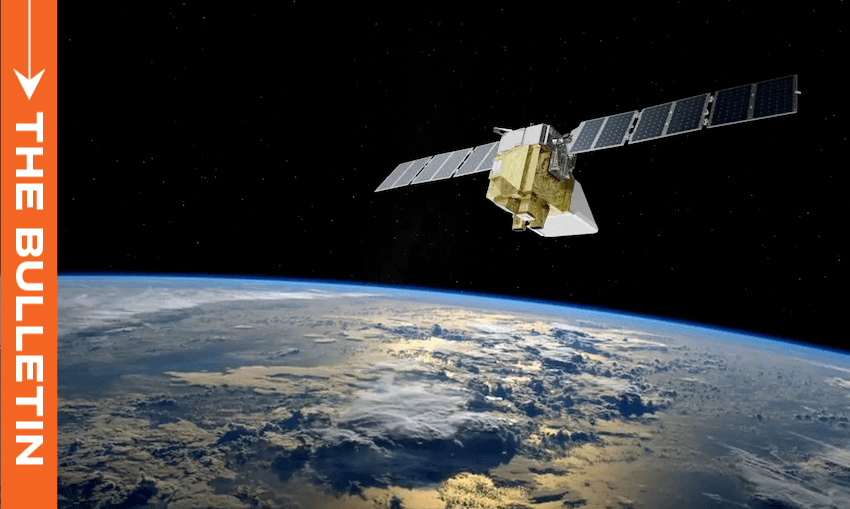New Zealand’s first publicly funded space mission has ended with a lost satellite and a debate about how we spend our money in space, writes Catherine McGregor in today’s extract from The Bulletin.
To receive The Bulletin in full each weekday, sign up here.
A sudden silence in orbit
When MethaneSat lost contact last month, it marked an abrupt end to New Zealand’s first publicly funded space mission – and a major setback for local climate science. The satellite, part of an international effort led by the US Environmental Defense Fund, was designed to “name and shame” major methane polluters. As The Guardian’s Veronika Meduna explains, MethaneSat’s main focus was on detecting methane leaks from oil and gas production worldwide; the New Zealand-led side project tracked methane release from agriculture, which accounts for almost half of our greenhouse gas emissions. Meduna reports that in total New Zealand contributed NZ$32 million to the mission – $3m more than the figure widely quoted in last week’s headlines.
Apportioning blame
The questions now are less about whether MethaneSat was a good idea and more about whether its problems should have been spotted sooner. Soon after launch, the satellite faced repeated technical issues, including difficulties with its thrusters and unexpected shutdowns caused by solar activity. Nicholas Rattenbury, Auckland University associate professor of physics, points out that “the principle of caveat emptor is true for spacecraft as much as it is for purchasing a car”. While NZ was not involved in the design and testing, “we were certainly entitled to relevant information to make a fully informed decision on whether or not to invest”.
His colleague, astrophysicist Richard Easther, suggests NZ needs to shoulder some of the blame. Speaking to the Sunday Star Times’ Jonathan Killick (paywalled), Easther argues local checks on the satellite’s design and readiness were too light, especially given the “major problems” that became clear long before contact was lost. All experts seem to agree that New Zealand may have relied too much on assurances from overseas partners instead of independent reviews. It’s one of the main questions that the postmortem, when it comes, will have to answer.
Space agency under scrutiny
The MethaneSat failure has turned the spotlight on how New Zealand runs its space activities. The New Zealand Space Agency, formed in 2016 and now with Judith Collins as its minister, acts both as regulator and supporter of the sector. Simon Hunt, writing for BERL, describes it as a “one-stop shop” for space policy and business support, noting its advantage in being “not burdened down with outdated policies and processes”.
But some researchers argue this dual role can be a conflict. As UoA’s Priyanka Dhopade and Catherine Qualtrough write in The Conversation, the set-up of the agency risks “a conflict of interest between promoting sustainability and fostering economic growth”. Sustainability in space is a growing international concern, Dhopade and Qualtrough write. As the amount of debris in space continues to skyrocket (sorry), scientists are also turning their attention to emerging issues like “ozone depletion from rocket launches and the accumulation of alumina and soot particles in Earth’s atmosphere as re-entering objects burn up”.
The rise of Rocket Lab
While MethaneSat drifts in silence, New Zealand’s biggest space player is enjoying a record run. Rocket Lab – officially a US company – is now valued at over NZ$30 billion, with the share price hitting a record high of around US$38 (NZ$63). The Herald’s Chris Keall reports (paywalled) that two factors are fuelling Rocket Lab’s rise: fallout from SpaceX founder Elon Musk’s feud with Donald Trump, and the upcoming first test launch of Rocket Lab’s “much larger, crew-capable rocket, the Neutron – which will put it toe to toe with SpaceX for the first time”.
But the company’s success has also attracted protest, reports The Spinoff’s Gabi Lardies. Critics have accused Rocket Lab of enabling military surveillance, including through launches of BlackSky satellites allegedly used by Israel’s defence forces. Last Friday Rocket Lab sites were picketed, while Palestine Solidarity Network Aotearoa has referred CEO Peter Beck, Judith Collins and others to the office of the prosecutor of the International Criminal Court. Beck has dismissed the claims, insisting the company abides by New Zealand law and doesn’t launch weapons. Still, the sight of picket lines outside a NZ success story is a reminder that space, like politics, is never free from earthbound controversies.


